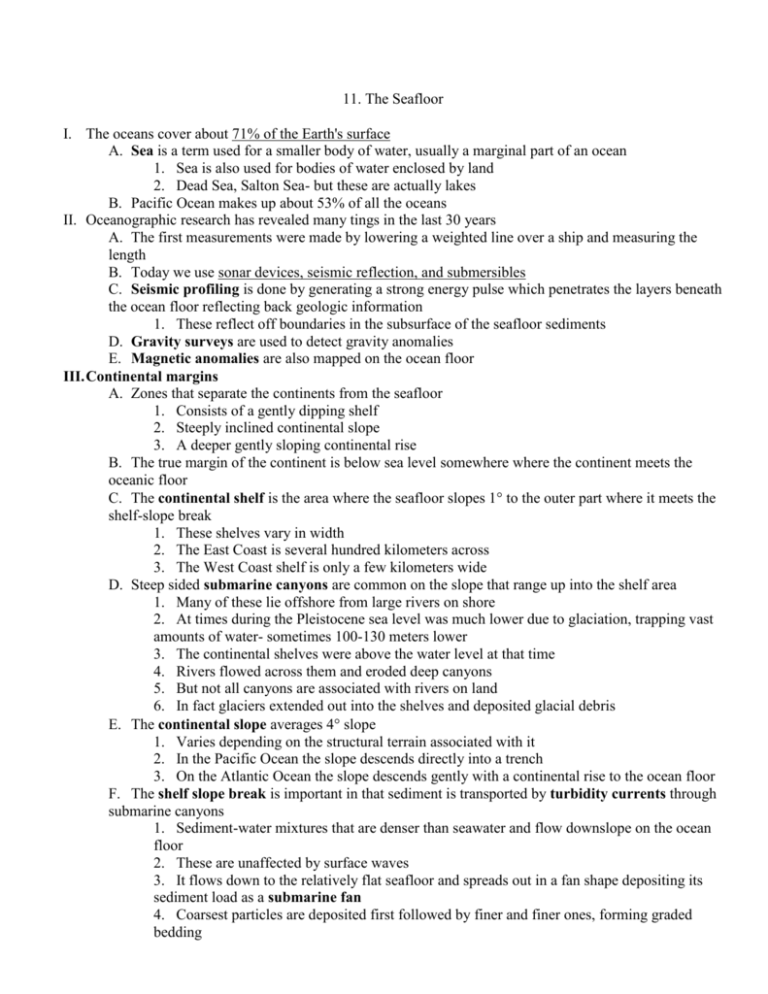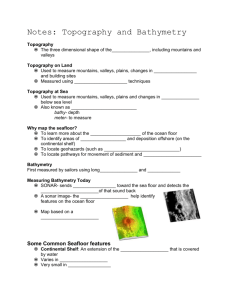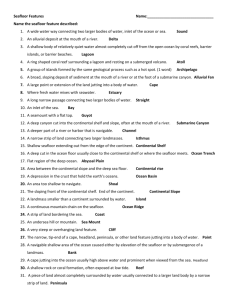11.Seafloors
advertisement

11. The Seafloor I. The oceans cover about 71% of the Earth's surface A. Sea is a term used for a smaller body of water, usually a marginal part of an ocean 1. Sea is also used for bodies of water enclosed by land 2. Dead Sea, Salton Sea- but these are actually lakes B. Pacific Ocean makes up about 53% of all the oceans II. Oceanographic research has revealed many tings in the last 30 years A. The first measurements were made by lowering a weighted line over a ship and measuring the length B. Today we use sonar devices, seismic reflection, and submersibles C. Seismic profiling is done by generating a strong energy pulse which penetrates the layers beneath the ocean floor reflecting back geologic information 1. These reflect off boundaries in the subsurface of the seafloor sediments D. Gravity surveys are used to detect gravity anomalies E. Magnetic anomalies are also mapped on the ocean floor III. Continental margins A. Zones that separate the continents from the seafloor 1. Consists of a gently dipping shelf 2. Steeply inclined continental slope 3. A deeper gently sloping continental rise B. The true margin of the continent is below sea level somewhere where the continent meets the oceanic floor C. The continental shelf is the area where the seafloor slopes 1 to the outer part where it meets the shelf-slope break 1. These shelves vary in width 2. The East Coast is several hundred kilometers across 3. The West Coast shelf is only a few kilometers wide D. Steep sided submarine canyons are common on the slope that range up into the shelf area 1. Many of these lie offshore from large rivers on shore 2. At times during the Pleistocene sea level was much lower due to glaciation, trapping vast amounts of water- sometimes 100-130 meters lower 3. The continental shelves were above the water level at that time 4. Rivers flowed across them and eroded deep canyons 5. But not all canyons are associated with rivers on land 6. In fact glaciers extended out into the shelves and deposited glacial debris E. The continental slope averages 4 slope 1. Varies depending on the structural terrain associated with it 2. In the Pacific Ocean the slope descends directly into a trench 3. On the Atlantic Ocean the slope descends gently with a continental rise to the ocean floor F. The shelf slope break is important in that sediment is transported by turbidity currents through submarine canyons 1. Sediment-water mixtures that are denser than seawater and flow downslope on the ocean floor 2. These are unaffected by surface waves 3. It flows down to the relatively flat seafloor and spreads out in a fan shape depositing its sediment load as a submarine fan 4. Coarsest particles are deposited first followed by finer and finer ones, forming graded bedding 5. These are triggered by some event like an earthquake nearby G. They have never been observed but in 1929 a series of undersea cables were broken after an earthquake 1. Breaks near the epicenter occurred when the earthquake hit 2. Breaks in the cable happened later in succession the further away from the epicenter 3. This allowed geologist to calculate the speed of the turbidity current a) Traveled at 80 km/hr on the continental slope b) Slowed to 27 km/hr on the ocean floor H. There are even deep canyons below the slopes that cannot be accounted for by rivers- these must be created by turbidity currents in the deep basins IV. Types of Continental Margins A. Active Continental Margin 1. Leading edge of the continent is being subducted 2. Characterized by seismically, young mountain range, andesitic volcanism B. Passive Continental Margin 1. Site of former rifting of the continent 2. Deposition of sediments 3. Lacks seismic activity and recent volcanism or any trench structure C. Deep Ocean Basin 1. Abyssal Plains a) Flat surfaces covering vast areas of the seafloor b) Results from sediment deposition probably from turbidity currents 2. Oceanic Trenches a) Long narrow features where ocean floor is being subducted b) Greatest ocean depths - up to 8000-11,000 m c) Negative gravity anomalies d) Benioff Zones and intermediate and deep focus earthquakes 3. Oceanic Ridges a) Mid-Atlantic Ridge is more than 2000 km wide and rises 2-2.5 km above the ocean floor b) The system is close to 65,000 km long c) Composed of basalt and gabbro and show tensional forces d) Steeper topographic ridges are spreading at a slower rate than shallower ridges e) May also have a rift along its crest 4. Seafloor Fractures a) Mid ocean ridges are not continuous features b) They are offset by transform fractures perpendicular to the ridges c) Run for hundreds of kilometers d) Shallow earthquakes formed 5. Seamounts, guyots and aseismic ridges a) Volcanic features that rise out of the ocean floor b) Guyots are flat topped seamounts (1) Originally extended above sea level (2) Were moved along on the plate away from the spreading ridge and sank as the plate cooled leaving an island eroded by waves beneath the water level c) Aseismic ridges are thought top be parts of continents that have been separated during rifting (1) Most these feature are formed from hot spots like in the Hawaiian Islands and Emperor's Seamounts V. Submarine hydrothermal Vents A. Water seeping through fractures is heated by hot rocks and rises to the seafloor in hot springs B. In the Red Sea dense brines were found to have accumulated on the ocean floor with thick deposits of metal rich materials C. The submersible Alvin found black smokers discharging hot metal rich plumes D. Communities of organisms live here including bacteria, crabs, mussels, starfish, and tubeworms E. The food chain is provided by bacteria that live in darkness and practice chemosynthesis 1. Digest sulfur compounds 2. Provide nutrients for themselves and other organisms F. Mineral potential is great because of the hydrothermal circulation 1. Seawater circulates through hot rocks and picks up minerals and especially metals and sulfides, discharging them on to the ocean floor 2. Precipitates iron, copper , and zinc sulfides 3. These deposits have been found on land and are major sources of metals VI. Deep sea sedimentation A. Usually composed of fine grained deposits B. Can be made of coarse sediment derived from icebergs melting and dropping their contents C. Manganese nodules have been found that precipitates on the ocean floor D. Pelagic clay- fine grained clay deposits E. Ooze composed of fine shell material 1. Calcareous ooze 2. Siliceous ooze VII. Seafloor Spreading A. Interest in mapping the ocean basins increased in 1960's revealing an oceanic ridge system some 65,00 km long, making this ridge the longest mountain chain in the world B. The mountain range in the Atlantic Ocean nearly divided the Atlantic Ocean basin into two equal parts C. Harry Hess in 1962 proposed the theory of seafloor spreading to account for the movement 1. He proposed that the continents do not move across oceanic crust but that they move together 2. He used the studies of guyots in his oceanographic research to explain how the crust is formed at the ridges and moves laterally away from the ridge 3. He also proposed a mechanism that Arthur Holms developed in 1930's of thermal convection cells 4. This consisted of thermal upwelling at the ridges and subduction at the deep sea trenches D. To test this hypothesis paleomagnetic readings should be recorded in the new crust forming at the ridges, with the youngest rocks near the spreading center 1. Also magnetic reversals will be recorded in the rocks spreading apart 2. Unusual patterns were found off the coast of North America 3. These were roughly north-south parallel strips of cut and offset by east-west fractures 4. This pattern was eventually found throughout the ocean basins at spreading ridges E. Studies did find that the youngest rocks were nearest the spreading ridges F. The oldest oceanic rocks found were only 180 million years while continental crust was 4 billion years old G. This confirmed that the ocean basins were young features and were responsible for the movement of the continents H. Deep sea drilling projects and seismic profiles have confirmed much of the ideas of seafloor spreading 1. Also fossil sediments on the ocean floor confirm this too 2. Sediments that accumulate on the ocean floor are at most a few hundred meters thick 3. Thinnest at the mid ocean ridges as would be expected because these are the youngest rocks with little time to accumulate sediment 4. Thickens with distance from the ridges VIII. Reefs are wave resistant structures made of the skeletons of organisms A. Commonly called coral reefs they are actually made up of sponges, corals, shells, and algae 1. Fringing reefs -attached to islands like in Hawaii 2. Barrier reefs separated from mainland by a lagoon 3. Atoll is a circular reef formed around a volcanic island that subsides below sea level a) As the island subsides the reef continues to grow upward b) Leaves a circular lagoon that rests on a submerged volcano IX. Resources A. Methane hydrates are deposits that are created by bacteria and may be a vast source of energy lying on the ocean floor 1. They are bound up in networks formed by frozen water 2. Have been know about for many years 3. It is unknown if they can be used as an energy source 4. Contain double the amount of carbon as coal, oil or gas B. Mineral deposits- iron, copper, zinc, and other metals C. Seamounts are known to have metal deposits several cm thick of cobalt and manganese







